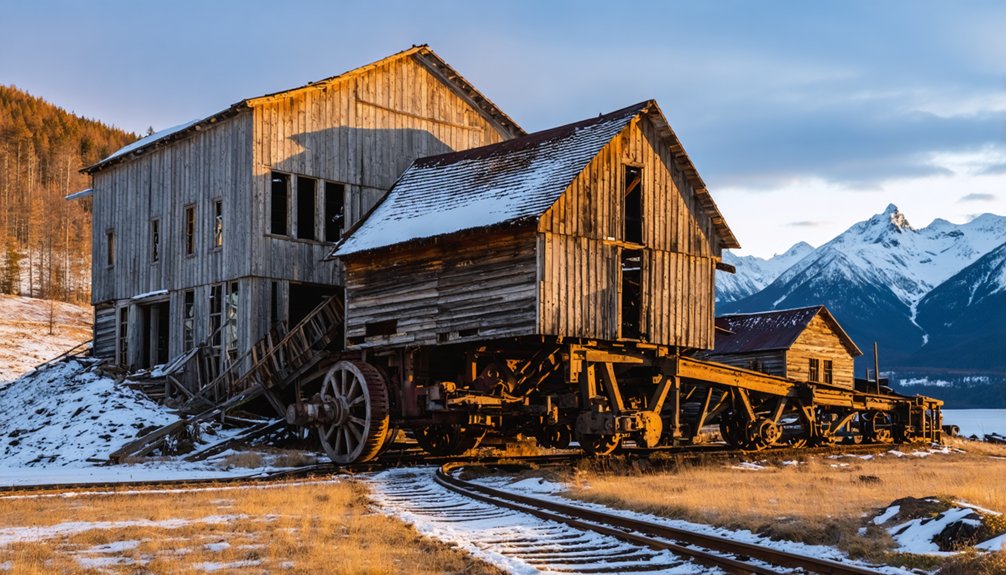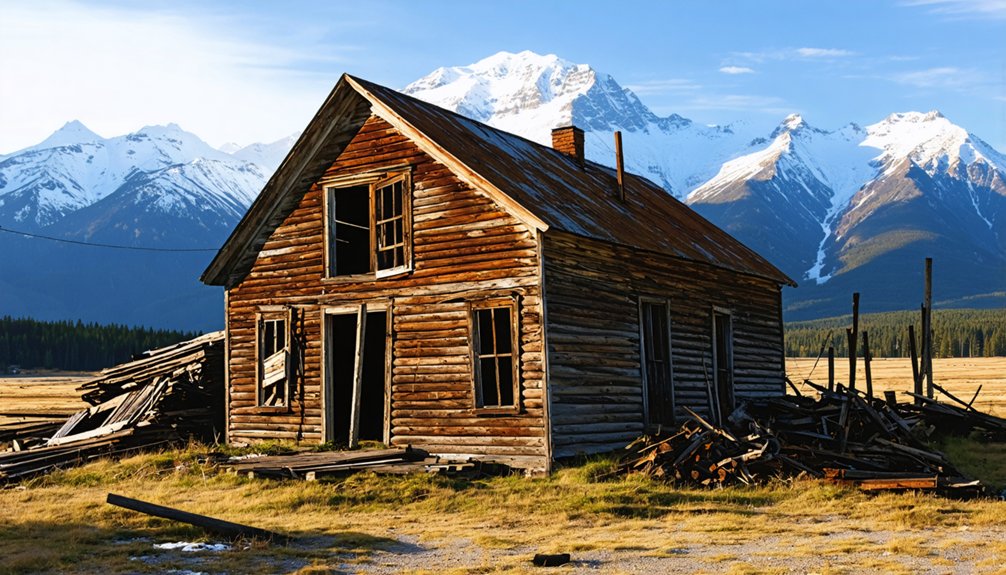You’ll find Ophir, Alaska nestled in the heart of gold rush territory, where prospector Jack McLaughlin’s 1887 discovery sparked a mining boom that peaked with 1,000 residents in 1907. The biblical namesake settlement thrived until the 1950s, when declining gold yields transformed it into a ghost town. Today, you’ll spot scattered remnants of mining equipment and log cabins, while the site serves as a checkpoint for the legendary Iditarod Trail Sled Dog Race, preserving tales of Arctic survival and golden dreams.
Key Takeaways
- Ophir, Alaska was a gold rush town established in the late 1800s, reaching its peak population of 1,000 residents around 1907.
- The town experienced rapid decline, dropping from 122 residents in 1910 to just 22 by 1920, eventually becoming a ghost town.
- Today, remnants include foundations, collapsed walls, and a gravel runway, though most structures have deteriorated due to harsh weather.
- The site serves as a checkpoint for the Iditarod Trail Sled Dog Race, maintaining its connection to Alaska’s historical heritage.
- Mining operations along Ophir Creek ceased by 1955, marking the end of the town’s gold rush era.
The Biblical Name Behind Alaska’s Golden Dream
Dreams of biblical wealth inspired the naming of Ophir, Alaska, during the late 1800s gold rush era.
You’ll find striking parallels between this frontier town and its ancient namesake, as both places captured humanity’s eternal quest for riches. The biblical significance stems from the Old scripture, where Ophir represented a legendary source of gold and precious items for King Solomon’s kingdom.
When gold was discovered in this Alaskan frontier, miners drew upon this wealth symbolism to christen their new settlement. They hoped their Ophir would mirror the abundance of its biblical counterpart. The town flourished until mining activity declined in 1955. At its peak around 1907, the town’s population reached 1,000 as prospectors flooded the area.
While the exact location of the original Ophir remains unknown today, its promise of untold riches lives on through this Alaskan ghost town, where prospectors once pursued their dreams of striking it rich.
From Boom to Bust: Population Rise and Fall
You’ll find that Ophir’s most dramatic population surge occurred in 1907-1908, when approximately 1,000 gold seekers flooded into the area seeking their fortunes in newly discovered placer deposits.
The town’s official recognition came in the 1910 U.S. Census, which recorded 122 residents, marking the beginning of traceable demographic data. Like the ancient gold of Ophir mentioned in archaeological discoveries, this Alaskan town’s precious metal drew fortune seekers from far and wide. Named after biblical accounts of wealth, this settlement reflected the same unattainable riches that inspired countless treasure hunters throughout history.
The subsequent decade brought a devastating decline, with the 1920 census showing just 22 residents remaining, an 82% decrease that signaled the end of Ophir’s boom years.
Peak Population Surge 1907
When gold was discovered near Ophir Creek in early 1908, the region had already experienced a remarkable population surge, with approximately 1,000 people flooding into the area from Nome and Fairbanks by spring 1907.
The gold rush triggered a massive mining migration that would transform this remote Alaskan wilderness into a bustling hub of activity.
You’d find nearly 750 men working the mines throughout the district, contributing to a total population of about 1,600 residents.
The Iditarod Trail became a crucial lifeline, connecting Ophir to McGrath, its primary supply center.
While infrastructure remained basic, the region’s economic growth hinged on the development of mining operations and trade routes, despite challenging geographical conditions and harsh climate limitations.
Located along the Kuskokwim River, the area provided vital waterway access for transporting supplies and equipment.
Rapid Decline After 1910
The dramatic population surge in Ophir proved short-lived, as the 1910 census revealed only 122 residents remained in the once-bustling mining town.
By 1920, you’d have found just 22 people left, marking a staggering 82% decline as economic migration took hold. The depletion of placer gold along Ophir Creek triggered an exodus, with miners seeking better prospects elsewhere in Alaska.
Community fragmentation accelerated through the 1930s, when the population dwindled to 19. Today, the area serves as a vital Iditarod Race checkpoint for mushers traversing the historic trail. A devastating brush fire in the 1970s destroyed what remained of the original townsite.
While a brief uptick brought 84 residents back by 1940, this temporary rebound couldn’t halt the town’s downward spiral.
By 1950, only 68 people called Ophir home. The harsh climate and remote location, combined with the lack of new mineral discoveries, sealed the town’s fate.
After 1950, Ophir vanished from census records entirely.
Gold Mining Legacy and Economic Impact

Gold fever struck Ophir Creek in 1887 when prospector Jack McLaughlin’s discovery sparked a transformative period in Alaska’s mining history.
As you explore Ophir’s legacy, you’ll find that gold mining drove its economic resilience through the early 1900s, peaking with a population of 1,000 during 1907-1908. The area yielded significant deposits of native gold and pyrite, as documented in numerous geological surveys. Mining operations employed various techniques including hydraulic plants that evolved over time.
The town’s prosperity attracted miners, merchants, and support services, creating a vibrant frontier economy.
Life in the Arctic Mining Town
In Ophir’s brief summer mining season, you’d spend up to sixteen hours daily wielding picks and sluices along Ophir Creek, racing against time before winter’s freeze halted operations.
The high shipping costs made obtaining supplies and equipment especially challenging for miners trying to maintain their operations.
You’d adapt to severe winter conditions by stockpiling wood for heating, preserving food stores, and maintaining minimal activity during the polar nights when temperatures plunged below freezing.
During these dark months, you’d rely on dog sleds for essential transportation while focusing on equipment repairs and planning for next season’s operations in the warmth of your basic wooden shelter.
Daily Mining Routines
While harsh Arctic conditions dictated much of life in Ophir, miners maintained rigorous daily schedules that maximized the brief summer season’s productivity.
You’d find yourself working mining shifts exceeding 12 hours, operating everything from simple panning equipment to massive diesel-powered dredges. Regular machinery maintenance was essential, as breakdowns in these remote conditions could halt operations for days.
Your daily routine would’ve included:
- Rising early for communal breakfast in shared bunkhouses
- Working long shifts at placer mining operations
- Maintaining water pumps and sluice boxes between shifts
- Ending days with equipment checks and social gatherings
Whether you were part of a large-scale dredging operation or working a small claim, success depended on maximizing every hour of daylight during Alaska’s short summer season.
Winter Survival Methods
Mining operations in Ophir ground to a halt each winter as the harsh Arctic climate demanded a complete shift in priorities from gold extraction to pure survival.
You’d need to fortify your log cabin with double-layered walls and stockpile firewood before the first snowfall. Your winter clothing had to include multiple layers of wool and fur, with specially designed mukluks to prevent frostbite in the extreme cold.
Food storage became critical to survival, with root cellars and snow pits preserving your essential supplies. You’d maintain a steady diet of dried meats, beans, and high-fat foods to keep your body generating heat.
When traveling, you’d rely on dog sleds and well-maintained trails, while the community worked together, sharing resources and indigenous knowledge to guarantee everyone’s survival through the brutal Arctic winter.
The Iditarod Connection: Modern-Day Significance

Although Ophir’s bustling mining days have long since passed, the ghost town maintains profound significance as an important checkpoint along the Iditarod Trail Sled Dog Race.
You’ll find this historic waypoint situated where mushers and their teams climb an 800-foot elevation over nine miles from Takotna, testing both human and canine endurance.
The Iditarod checkpoint at Ophir serves multiple essential functions:
- Provides strategic rest after crossing the 1,200-foot divide between river basins
- Preserves the connection to Alaska’s gold rush heritage
- Offers significant resupply opportunities for race teams
- Maintains the historical integrity of the original mining trail system
This ghost town’s role in the modern race embodies the spirit of Alaska’s sled dog heritage while keeping alive the rugged history of the mining era.
Preserved Structures and Historical Remnants
Today’s visitors to Ophir encounter sparse physical remnants of what was once a thriving gold mining settlement.
The abandoned ruins of Ophir stand as silent witnesses to Alaska’s golden past, their weathered remains slowly fading into wilderness.
You’ll find foundations, collapsed walls, and scattered debris where structures once housed 122 residents at the town’s peak in 1910. The site faces significant preservation challenges due to Alaska’s harsh climate and its remote location.
The most notable surviving infrastructure is a gravel runway, constructed before 1949, which serves as both a landmark and occasional landing strip.
As you explore the area, you’ll discover rusted mining equipment, vintage bottles, and discarded metal fragments that hint at the settlement’s historical significance.
Unlike other Alaskan ghost towns, Ophir lacks protected status, leaving its archaeological treasures vulnerable to both natural decay and human interference.
Frequently Asked Questions
What Were the Major Causes of Death Among Ophir’s Early Residents?
Like a deadly roll call, you’d have faced rampant disease outbreaks including tuberculosis and influenza, devastating mining accidents from shaft collapses, hypothermia from harsh winters, and malnutrition from limited supplies.
How Did Families Educate Their Children During Ophir’s Peak Years?
You’d find most children learned through home schooling from their parents, focusing on basic literacy and arithmetic. Kids often received practical mining education by working alongside adults in the community.
What Indigenous Tribes Lived in the Ophir Area Before Mining?
While countless generations shaped tribal history here, you’d find Athabascan peoples were most likely the Indigenous culture group, particularly the Dena’ina, Koyukon, and Deg Hit’an/Holikachuk communities.
How Much Gold Was Extracted From Ophir During Its Active Period?
You’ll find documented gold extraction reached roughly 707,000 ounces across the Council district, with Ophir Creek yielding 50,000 ounces in 1901 alone, though exact mining methods aren’t fully recorded.
Were There Any Significant Conflicts Between Miners in Early Ophir?
You’ll find significant miner rivalries erupted over gold claims and water rights, with resource disputes intensifying during economic downturns, as prospectors and companies fought for control of Ophir’s richest deposits.
References
- https://michael-hankins.com/2025/08/09/ann-sanders-mystery-maiden-of-ophir-alaska/
- https://iditarod.com/zuma/virtual-trail-journey-ophir-at-mile-352/
- https://kids.kiddle.co/Ophir
- https://www.blm.gov/sites/blm.gov/files/Programs_NLCS_Iditarod_Trail-Historic-Overview.pdf
- https://www.gi.alaska.edu/alaska-science-forum/innoko-long-river-short-people
- https://www.youtube.com/watch?v=C87_ZqvgQ_M
- https://www.travelalaska.com/explore-alaska/articles/iditarod-route-history-alaska
- https://en.wikipedia.org/wiki/Ophir
- https://thediggings.com/places/ak290-99936684
- https://live.laborstats.alaska.gov/pop/estimates/present/jun022011.pdf



